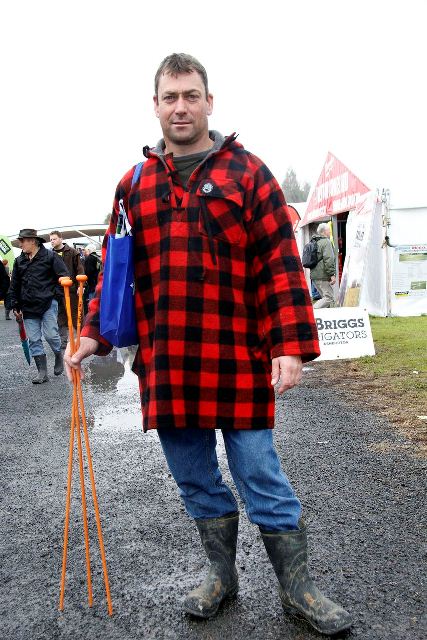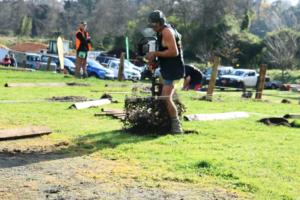The stereotypes of a farmer
Gumboots, Swanndris, and stubbies are commonly associated as farming attire. Ali Brady talks to a farmer to see if the strerotypes add up.
A man walks into a store wearing knee-high gumboots. The store is RD1 in Hamilton and the man is farmer Timothy Wilson. The clothes, he says, are just part of who he is.

Wilson, 33, started officially farming after he dropped out of high school at 16, knowing school just “wasn’t for me”.
“I lived on a dairy farm and the day after I left high school my dad put me to work,” Wilson says. “I didn’t always dress this way.”
Wilson admits to wearing trendy clothing while still in school, but that wasn’t practical for the work he was starting in the paddocks.
Seventeen years later Wilson says he wouldn’t dream of going to work in what he wore back then.
“I’d freeze to death for one,” he says. “I don’t wear this because I think it makes me look good, I wear this because I want to work. Looking good is just a bonus.”
Also in the store is Michael Smith, 26. He is a fellow Waikato farmer, but unlike Wilson his gumboots are neatly placed by his door at home today.
“I keep the farm clothes for on the farm,” he says. “I’ve still got to impress the ladies.”
For four days annually more than 800 exhibitors come together at the National Agricultural Fieldays to attract the attention of the modern day farmer, people like Wilson and Smith, and nearly 100 stalls are dedicated to clothing and beauty.
Among the exhibits is Dirty Man Limited, a skin care range “for men who like it dirty”.
Will Michael Smith be giving this exhibit a look at the 2013 Fieldays? The young farmer laughs.
“Wouldn’t hurt,” he says. “Ladies are hard to meet when you’re working all day, in any job, but I think as farmers we have to try harder because you’re not going to go down to the cow shed in the morning and bump into someone, are you?”
Wilson met his wife of four years at a family get together, agreeing with Smith about how hard it was to meet a woman when farming. He says he went “the extra mile” to win her heart.
“I don’t remember any products like that [Dirty Man Ltd] back when I needed them, but it would have been helpful… I had to call my sister once from the shop to know what stuff to get.”
In a country with more than 23,000 farmers, these two men aren’t surprised there’s a stereotypical image around their occupation.
But they also can’t deny that there are elements to that stereotype that they would consider fact.
Number one: Gumboots. Smith doesn’t believe a farmer without a pair of gumboots can really call themselves a farmer at all. Wilson’s son is three years old and it was at the 2012 Fieldays Wilson got the boy his first pair of gumboots.
“He’s a little farmer in the making,” Wilson says. “He’s only three and he knows you can’t go to the farm with dad without gumboots on.”
Number two: Merino socks. An article of clothing that is not dwelled on heavily by many is considered “essential” by both these farmers.
With exhibitors at the Fieldays like the Sock Lady the farmers are hoping to stock up.
“[Like] gumboots you wear them every day and winter’s coming… you can’t have too
many socks,” Smith says.
Number three: Beanies. Most days they get up before the sun – is it that surprising farmers look for a way to keep their ears warm?
While Smith currently only has one beanie, he says there comes a point every year where between the fog and the wind, the beanie gets used almost every day.
Number four: Gloves. Anyone who’s ever fallen victim to frozen fingers knows how hard it is to really accomplish anything productive, so keeping your fingers and hands warm is important on a farm, Wilson says.
“My wife and I were there [Fieldays] one year and we separated to look around and probably around half an hour later we found each other and the only thing we had both brought were some gloves,” Wilson says. “It’s just one of those things.”
And mostly making regular appearances during the summer months, number five: Stubbies. If the popular 2005 L&P “stubbies ad” comes to mind, not to worry, Smith insists his stubbies not only generally have two pockets but they are also big enough for his set of keys.
“I think I only wear them because I remember my dad wearing them on the farm, becomes habit,” Smith says, “They’re comfortable though.”
Despite similarities there is no easy way to paint a picture of the modern New Zealand farmer.
Fieldays is the world’s largest agricultural event and over four days draws in a crowd of more than 130 thousand visitors. Farmers travel from all over New Zealand to attend the event and despite the created stereotypes not one farmer will be identical to another.
“There’s always going to be them [stereotypes] and rather than fighting it, it’s easier to just embrace it,” Smith says “I’d say I was a typical Kiwi guy, but someone completely different to me might come along and say the same thing. What’s typical, anyway?”




